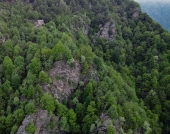
 1
1




 1
1






 3
3




 1
1




 1
1




Care to elaborate more Jay? You using a hammock/tarp combo or what?
 3
3




Bryan Usille wrote:Anyone every stay or live in a yurt in a cold climate? I know the climate where it originates can be pretty rough, but I wanna hear some first hands from people in a usda zone 5 or lower, maybe some midwest type climates. I really liking the idea of a natural yurt (felt and canvas).
“Uncertainty is an uncomfortable position. But certainty is an absurd one.”
― Voltaire




 10
10




“Uncertainty is an uncomfortable position. But certainty is an absurd one.”
― Voltaire

 2
2




 2
2




Catie George wrote:Mike, how is it for mice? I've always been interested in yurts, but memories of the mice making their annual fall trek into the loghouse I grew up in have always given me reservations. Very impressive that it stays warm to -40C!
“Uncertainty is an uncomfortable position. But certainty is an absurd one.”
― Voltaire








 1
1




 4
4




Catie George wrote:Thanks! Good to know about the hardware cloth, that's a good idea. I had wondered about them chewing through the yurt fabric itself.
“Uncertainty is an uncomfortable position. But certainty is an absurd one.”
― Voltaire
 2
2




Michael Helmersson wrote:There's a yurt in that snowbank, I promise.
"Every house where love abides and friendship is a guest, is surely home - and home sweet home - for there the heart can rest." ~Henry Van Dyke
 3
3




Tonya Hunte wrote:More pictures please!!! Did you pile the snow for warmth?
I'm also in Canada, and expect to buy a Groovy Yurt. I'll be assembling in Nova Scotia. Tell me all your stories. No seriously. ALL OF THEM. Pros, cons. Things you would have done differently. I need all the info LOL.
“Uncertainty is an uncomfortable position. But certainty is an absurd one.”
― Voltaire




Michael Helmersson wrote:
I'll leave you with this for now but please don't hesitate to ask questions. I'll see what photos we have to share.
Mike

"Every house where love abides and friendship is a guest, is surely home - and home sweet home - for there the heart can rest." ~Henry Van Dyke
 3
3




Tonya Hunte wrote:
Michael Helmersson wrote:
I'll leave you with this for now but please don't hesitate to ask questions. I'll see what photos we have to share.
Mike
What started you on your yurt journey? Why did you decide on a yurt over other housing? How did you deal with friends and family when you told them you'd be living in a yurt? What's your permaculture setup like, besides the whole living-in-a-yurt thing? What's your favourite thing about living in a yurt?
Expect more questions
“Uncertainty is an uncomfortable position. But certainty is an absurd one.”
― Voltaire
 6
6




“Uncertainty is an uncomfortable position. But certainty is an absurd one.”
― Voltaire
 1
1




Become extra-civilized!




Coydon Wallham wrote:What are the factors in choosing fabric for the yurt? I'm in zone4a. Not interested in anything plastic.
The good websites I've found have mentioned 10z cotton canvas, with 12z as a more durable choice for a long term structure. A site selling bolts I've found also mentions "#12 (11.5oz)" Duck canvas that is "a double fill fabric woven with a "plied yarn" construction". Would this yarn be a different weave of cotton or another source of material?
They also offer a 10oz 'Canvak' canvas as special for tents and tipis, which costs twice the other canvas.
What kind of felt would be appropriate for a yurt?
“Uncertainty is an uncomfortable position. But certainty is an absurd one.”
― Voltaire




Become extra-civilized!




Coydon Wallham wrote:Making my own. Was your Canvas all cut and presewn by the Groovy people?
It looks relatively simple to do the wall, just size it for the bolt width allowing for a few inches extra (haven't discerned exactly why yet). The top looks like a lot of sewing for a custom fit. There also seems to be a question of shrinkage...
“Uncertainty is an uncomfortable position. But certainty is an absurd one.”
― Voltaire
 1
1




Michael Helmersson wrote:In our case, we didn't have the time or the skills to build our own.
Become extra-civilized!




Coydon Wallham wrote:
Michael Helmersson wrote:In our case, we didn't have the time or the skills to build our own.
I don't have those either, but find that tackling challenges with the right methodology usually produces something good regardless.
Was yours a straight 12.5z cotton canvas? Any treatment or special weaves? Pre-shrunk? How long since you put it up?
“Uncertainty is an uncomfortable position. But certainty is an absurd one.”
― Voltaire




Many hands make light work.
Laughter is the best medicine.
 1
1




Kate Michaud wrote:Hi Michael.
I like the idea of your cold storage with a trap door underneath the yurt, very ingenious. Is the cold storage counter sunk in the ground to any degree?
Our water table was too high to dig the root cellar down, so we have been building up a berm around whole thing. It's still not complete, but close.
I'm going to refer this thread to a young couple who are ordering, or may have already ordered their yurt from the same company as yours, and are looking at moving onto my property for the long term.
Groovy Yurts was and is fantastic to deal with. Yves, the owner is a genuinely good person and seems to generate a gravitational pull that attracts similar people into his organization. We love our yurt and we love having the Groovy People visit us on their delivery journeys.
“Uncertainty is an uncomfortable position. But certainty is an absurd one.”
― Voltaire




Michael Helmersson wrote:
Kate Michaud wrote:Hi Michael.
I like the idea of your cold storage with a trap door underneath the yurt, very ingenious. Is the cold storage counter sunk in the ground to any degree?
Our water table was too high to dig the root cellar down, so we have been building up a berm around whole thing. It's still not complete, but close.
Become extra-civilized!
 4
4




Coydon Wallham wrote:
Any pics of the root cellar before the yurt went up? How about the trap door in action?
“Uncertainty is an uncomfortable position. But certainty is an absurd one.”
― Voltaire




 3
3




steven hobert wrote:Hello Michael.
We (my partner and I) really appreciated all your helpful information about the Groovy Yurt, yurt life, and the earthbag foundation/cellar. We'd love to ask you some more questions.
Before reading your post we had also come up with the idea of a "root cellar" underneath the yurt but didn't have an idea how to do it in a reasonable amount of time and with no experience. We are also thinking of the "root cellar" being above ground (at least for now) in order to save time and avoid potential water table issues.
And we are also leaning towards buying a 22' Groovy Yurt.
Could you give more details about how the yurt and platform (with insulation etc.) was done?
In your photo it looks like you have one thick beam going across but I assume you put more across to support your floor and wood cookstove etc . . .?
I assume you did not put any posts in the middle to hold up the floor, correct?
I believe you said the top of your floor was two layers of 1/2" plywood and underneath it 8" of styrofoam. How was the styrofoam secured to the plywood? did you have 8" joists between plywood floor and the beams? Was there any material below the styrofoam?
How did you secure the yurt to the foundation/ground?
Do you have a ramp going up to your door? how many feet off of the ground level is your yurt floor?
I'm sure we will think of lots more questions.
Thank you for your time
“Uncertainty is an uncomfortable position. But certainty is an absurd one.”
― Voltaire










|
Do not set lab on fire. Or this tiny ad:
Homestead Pigs Course
https://permies.com/wiki/365748/Homestead-Pigs
|







